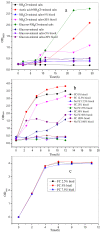Bio-oil based biorefinery strategy for the production of succinic acid
- PMID: 23657107
- PMCID: PMC3655842
- DOI: 10.1186/1754-6834-6-74
Bio-oil based biorefinery strategy for the production of succinic acid
Abstract
Background: Succinic acid is one of the key platform chemicals which can be produced via biotechnology process instead of petrochemical process. Biomass derived bio-oil have been investigated intensively as an alternative of diesel and gasoline fuels. Bio-oil could be fractionized into organic phase and aqueous phase parts. The organic phase bio-oil can be easily upgraded to transport fuel. The aqueous phase bio-oil (AP-bio-oil) is of low value. There is no report for its usage or upgrading via biological methods. In this paper, the use of AP-bio-oil for the production of succinic acid was investigated.
Results: The transgenic E. coli strain could grow in modified M9 medium containing 20 v/v% AP-bio-oil with an increase in OD from 0.25 to 1.09. And 0.38 g/L succinic acid was produced. With the presence of 4 g/L glucose in the medium, succinic acid concentration increased from 1.4 to 2.4 g/L by addition of 20 v/v% AP-bio-oil. When enzymatic hydrolysate of corn stover was used as carbon source, 10.3 g/L succinic acid was produced. The obtained succinic acid concentration increased to 11.5 g/L when 12.5 v/v% AP-bio-oil was added. However, it decreased to 8 g/L when 50 v/v% AP-bio-oil was added. GC-MS analysis revealed that some low molecular carbon compounds in the AP-bio-oil were utilized by E. coli.
Conclusions: The results indicate that AP-bio-oil can be used by E. coli for cell growth and succinic acid production.
Figures





References
-
- Lin CSK, Luque R, Clark JH, Webb C, Du C. Wheat-based biorefi ning strategy for fermentative production and chemical transformations of succinic acid. Biofuels Bioprod Bioref. 2012;6:88–104. doi: 10.1002/bbb.328. - DOI
-
- Zeikus JG, Jain MK, Elankovan P. Biotechnology of succinic acid production and markets for derived industrial products. Appl Microbiol Biot. 1999;51:545–552. doi: 10.1007/s002530051431. - DOI
-
- Luque R, Lin CSK, Du CY, Macquarrie DJ, Koutinas A, Wang RH, Webb C, Clark JH. Chemical transformations of succinic acid recovered from fermentation broths by a novel direct vacuum distillation-crystallisation method. Green Chem. 2009;11:193–200. doi: 10.1039/b813409j. - DOI
-
- Delhomme C, Weuster-Botz D, Kuhn FE. Succinic acid from renewable resources as a C4 building-block chemical—a review of the catalytic possibilities in aqueous media. Green Chem. 2009;11:13–26. doi: 10.1039/b810684c. - DOI
LinkOut - more resources
Full Text Sources
Other Literature Sources
Miscellaneous

